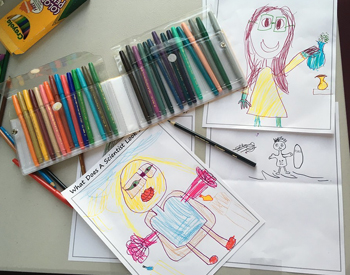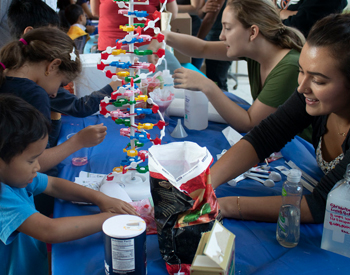Chemistry at Play
Oct. 31, 2019 | By Melissa Miller
Graduate students from the UC San Diego Department of Chemistry and Biochemistry celebrated National Chemistry Week (Oct. 20-26) by hosting a hands-on science fair for the next generation of scientists. With a little guidance, kids of all ages performed experiments that engaged the five senses.
 Many kids drew themselves as scientists when asked, “What Does a Scientist Look Like?” Understanding that anyone and everyone can be a scientist was one of the goals of the event. Photo by Melissa Miller, UC San Diego Physical Sciences
Many kids drew themselves as scientists when asked, “What Does a Scientist Look Like?” Understanding that anyone and everyone can be a scientist was one of the goals of the event. Photo by Melissa Miller, UC San Diego Physical Sciences
A dozen tables were set up in the courtyard outside Pacific Hall, each with volunteers from lab groups and student organizations eager to share their science. A few wore lab coats and some even handed out safety glasses before starting their experiments, but many setups looked more like a household kitchen demonstration than a laboratory.
Graduate student Mallory Evanoff volunteered with her lab group to help kids create “popping fruit caviar”’ using a whisk, measuring cups and a sifter. Juice was mixed with sodium alginate (salt made from seaweed) and then turned into gel with a calcium chloride solution (another salt used in foods). Going against standard laboratory practice, Evanoff encouraged the kids to taste the results.
“Hands on activities are always more memorable than learning in a lecture setting,” she said. “Elementary schoolers in particular are super fun to watch experiment. They seem to be pretty immune to some of the icky, slimy or bitter parts and are so excited for the end result.”
Members of the Chemistry Graduate Student Council taught kids how to make ice cream by banging a small bag of ingredients against the table. The McHugh research group had kids extracting DNA from a strawberry within minutes, the small stream of goo visible on the end of a toothpick. At the Society for Women in Graduate Studies in Chemistry’s demo, kids sniffed cans labelled only with chemical names and structural formulas, then had to guess what everyday item they were smelling.
Professor Valerie Schmidt’s lab group presented Harry Potter-themed demonstrations. The stations included making slime (troll bogies) from a few household ingredients and combining different extracts (potions) with colorful results. Schmidt, who describes science as “magic for Muggles,” sees the potential for events like this across all science and engineering departments at UC San Diego.
 Graduate students from Colleen McHugh’s lab helped kids extract DNA from strawberries using household ingredients. Photo by Tatiana Diaz-de-leon, UC San Diego Physical Sciences
Graduate students from Colleen McHugh’s lab helped kids extract DNA from strawberries using household ingredients. Photo by Tatiana Diaz-de-leon, UC San Diego Physical Sciences
“It would be wonderful to cultivate an atmosphere where the public is regularly invited to come to campus and join us in learning about STEM ideas, practices and general cool stuff,” she said.
Schmidt also set up a coloring station where kids were given a piece of paper with the question, “What does a scientist look like?” written across the top. Drawings included women and men, many wearing lab coats, gloves and safety goggles. Some were shown with flasks and beakers like those the kids had just been using themselves. And true to the San Diego vibe, one scientist was depicted with a surfboard.
The event served as a reminder that chemistry, and scientific exploration in general, can be fun. David Meyer, a UC San Diego math professor, brought his daughter to the event because she’s interested in chemistry.
“She thought it was great that she could do most of the experiments herself, in any order she liked, without being rushed,” he said. “She liked the grad students’ enthusiasm and the fact that they were explaining to her, in ways she understood, what was going on in the experiments.”
The kids weren’t the only ones learning. The ability to explain their science is an important skill for all scientists to practice. And with interested kids as an audience, the enthusiasm of the graduate student volunteers shined through. It wasn’t just the kids, but everyone, who left the event excited about chemistry.
Learn more about the groups that participated in All Hands-On!
